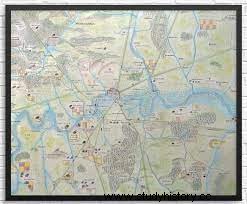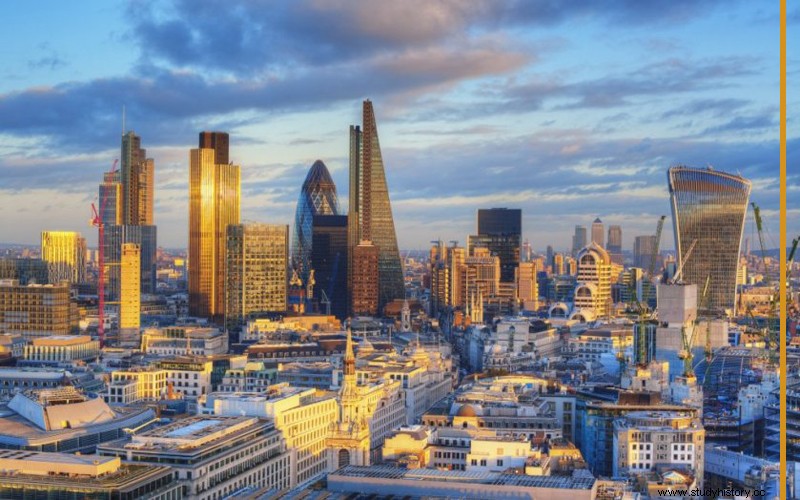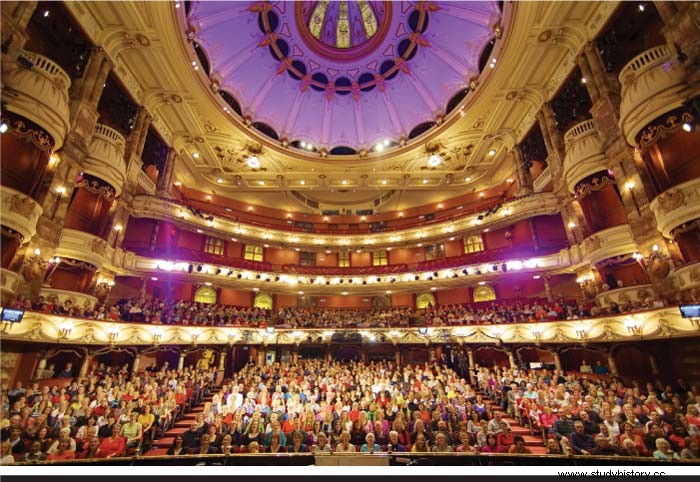
The City of London, the UK's capital, is one of the oldest in the world with almost two millennia of history. This city is one of the most cosmopolitan capitals. It is by far the largest city in the UK, and also the country's economic, transport and cultural center. The city is located at the top of the Thames, 50 miles into the North Sea of England. The City of London is the old core and financial center with an area of only 1-12 square kilometers. Many national authorities have been located in the neighboring town of Westminster for centuries. Modern London has 31 more districts north and south of the Thames. The London Assembly and the rapporteurs govern the territory of London.
London has four World Heritage Sites:London Tower; Kew Gardens; Palace, Westminster Abbey and St. Margaret's Church, and the old Greenwich Settlement. Greenwich Royal Observatory established Prime Meridian and Greenwich Meantime. The Tower of London is located in Kew Gardens; Buckingham Palace, the London Eye, Piccadilly Circus, St. Paul's Cathedral, Tower Bridge, Trafalgar Square and The Shard were other monuments. There are many museums, galleries, libraries, athletic events in London. British Museum, National Gallery, Natural History Museum and Tate Modern, British Library.
A brief history of London and its anthropology
Prehistory of London
The remains of a Bronze Age bridge on the south bank of the Vauxhall Bridge. This bridge possibly went through the Thames or reached an island that is now lost there. The radiocarbon dating between 1750 BC. and 1285 BC. were two of these forests. On the southern coast, the foundations of a massive wooden building dated between 4800 BC. and 4500 BC. There is no known function of the Mesolithic structure. Both are located on the south side, which leads into the Thames along the Effra River.
The Colonial Time of London
The history of this city begins with the Romans, according to anthropology. Excavations west of London found remains of circular dwellings dating back to 2000 BC. The Roman forces quickly came to rule most of the southeast of Britain; they began to occupy Britain under Emperor Claudius in 43 AD, at a position north of the swampy Thames Valley. London had two low hills with a bridge from the country to the south. They founded London. The earliest clear mention of London is from 60 AD. The Roman historian Tacitus wrote about a famous trading center.
Roman London
The Romans constructed the first large colony. There is evidence of scattered Brythonic villages in the region, around four years after the invasion in 43 AD, according to anthropology. Queen Boudica led the flames to the settlement of the Iceni tribe until about 61 AD. Colchester replaced a carefully planned iteration of Londinium, the capital of Britain's Roman province. Roman London had about 60,000 2 inhabitants at its highest level in the XNUMX. century.

Barbican Anthropology of London
That same year, the Iceni barbarians destroyed the village under the leadership of Queen Boudicca (Boadicea). The evidence can determine the flames. They had shot, raised and stretched St. Paul's Cathedral in the Walbrook Valley. After the sack, they rebuilt a large basilica with an isolated 500 meter long hall. Leadenhall Market, a cast iron and glass building created in 1881, is on the same site today. They also built Cripplegate Fort with an amphitheater next door at the end of the first century to protect the city.
In the early part of the 2nd century, the fortunes of Londinium changed around 150 AD. About 200 AD the defense constructed a land wall. On the edge of the Barbican and the tower hill, the remains of the wall can be seen. In the Middle Ages, they repaired and expanded the six Roman walls. They also renovated the public houses in the Thames and created a river wall during the 3rd century. The surface area was around 330 acres (approx. 135 ha). Londinium was less populated in the third and fourth centuries than in 125 AD. By the beginning of the fifth century, when the soldiers returned to Rome, the country had been abandoned. For the next two centuries, what took place in London is an assumption.
Anglo-Saxon London
From the 5th century, the fall of Roman control made London no longer a metropolis, according to anthropology. The fortified city of Londinium was abandoned. In the St Martin-in-the-Fields region, Roman culture remained unchanged. A little west of the ancient Roman city, formed by about five hundred, an Anglo-Saxon village, known as Lundenwic. The city had regrouped into a significant port. Large-scale production is little evidence. Repeated attacks by Vikings led to a decline in the 19820s. There are three registers; they were successful in 851 and 886. The latter was rejected in 994.

The Viking Age, according to the Anthropology of London
The Vikings established Danelaw over most of eastern and northern England according to anthropology. The borders were extended approximately from London to Chester. In 886, King Alfred publicly accepted it as a region of political and geographical dominance imposed by the Viking invasions. Alfred "recently" Londoners in the 886 Anglo-Saxon Chronicle. The abandoned Lundenwic has shown archaeological studies. Life and trade were restored within the ancient walls of Rome. London then flourished steadily until around 950, after which there was a significant increase.
The Conquest of London
London was the largest city in England in the 11th century beyond all comparisons. Westminster Abbey was one of the largest churches in Europe, built in the Romanesque style by Confessor King Edward. The former capital of Anglo-Saxon England was Winchester. But since then, London has been the most important platform for international trade and a defense base in wartime. In Frank Stenton's view:"He had the resources to build the dignity of a country's capital and its political self-awareness."
William, Duke of Normandy, was awarded to the King of England on Christmas Day 1066 after winning the Battle of Hastings. To bully the natives, in the southeast corner of the city, William built the Tower of London. The first of several Norman castles reconstructed in England. The Westminster Hall structure, near the abbey of the same name, began in 1097. He also built a new Westminster Palace on the hall.

Middle Ages in London
By the 12th century, the central government institutions had grown in size and complexity. It had previously followed the Royal English Court as it traveled through the kingdom. This was Westminster for most purposes; Winchester, however, brought the king's treasure into the tower. The city of Westminster has become a legitimate state capital. While England's largest metropolis and central commercial center is its separate neighbor. The City of London prospered under its rule, the London Corporation. It had about 18,000 inhabitants in 1100 and around 100,000 1300 in XNUMX, according to anthropology. By the middle of the fourteenth century, London lost over a third of its population. A catastrophe came in the form of the Black Death.
Early Modern London
London was the largest metropolis in the world from around 1831 to 1925, with 325 people per hectare in population. Crowded circumstances in London led to a cholera pandemic. This deadly pandemic killed fourteen thousand lives in 1848 and six thousand lives in 1866. Increasing traffic congestion led to the establishment of the first municipal railway network in the world. In 1889, when these districts established the London County Council around the capital. The Metropolitan Council oversees the construction of infrastructure facilities in the city.
London became primarily a center of global youth culture in the mid-1960s. The subculture Swinging London is typical and is associated with King's Road, Chelsea and Carnaby Street. During the period, the role of trendsetter was restored. In 1965, London's political boundaries were widened. The new Greater London Council expanded the city to accommodate them. The Provisional Irish Republican Army bombed London for two decades under the troubles of Northern Ireland. THE ARMY began bombing Old Bailey in 1973. The Brixton uprising in 1981 underscored racial differences.

Late Modern London
In the decades after World War II, the population of Greater London fell slowly. According to anthropological historians, they observed from an estimated peak in 1939 of 8.6 million to about 6.8 million in the 1980s. London's main ports moved downstream to Felixstowe and Tilbury, and revitalization in the London Docklands area, especially Canary Wharf. This is part of the ever-growing position of London in the 1980s as a major worldwide financial center. In the 1980s, the Thames Barrier was completed to defend London against the tidal waves in the North Sea.
London's modern age
With the introduction of the Greater London Council, it was dissolved in 1986, leaving London without a central administration until 2000. The Millennium Dome, London Eye and Millennium Bridge are built to mark the beginning of the 21st century. London won the 2012 Summer Olympics on July 6, 2005. As the first city in the world to host three Olympic Games. On July 7, 2005, a series of terrorist attacks attacked three London Underground and a double-decker bus.
As the Nylon King, Time rated London as the world's third most influential international city in 2008. He estimated the population of Greater London at 8.63 million in January 2015, the highest since 1939. Britain as a whole chose to leave the EU during the 2016 Brexit referendum. chose the majority of London constituencies to stay in the EU.

Cultures
London as an entertainment hub
Entertainment dominates the London economy. An estimate from 2003 gave London 25.6 events per 1,000 people for a fifth of the entire leisure industry in the UK. According to official data, the city is the third busiest film production center. The offers come more live comedy than any other city in the world. This city has the largest theater audience in the world. It represents the four major fashion cities.
Theaters
Within the City of Westminster, London, Leicester Square, home to London and international film premieres, is the entertainment hub. Piccadilly Circus is known for its giant electronic advertising. There are many theaters, pubs, bars, restaurants and theaters in London, including the City of Chinatown. The City of London is also part of the theater. Andrew Lloyd Webber has been in town since the late 20's. His musical has dominated the West End theater. The Royal Ballet, Royal Opera and British Opera are located in London. Other artists also performed at the Royal Opera House, London Coliseum, Sadler's Wells Theater and the Royal Albert Hall.
Upper Street of Islington at 1km extends north from Angel with over 1km of eateries in the UK. Oxford Street, which is almost a mile long and is the largest retail area in the UK. It is Europe's busiest retail corridor. There are several businesses and department stores on Oxford Street, including the world-famous Selfridges Flagship Store. Knightsbridge is located southwest, home to the equally famous department store Harrods.

London has designers like Vivienne Westwood, Galliano, Stella McCartney, Manolo Blahnik and Jimmy Choo. This city's famous art and fashion schools are a global fashion center. The ethnically diverse populations of London provide a great variety of dishes. Bangladeshi restaurants include Brick Lane and Chinatown Chinese.
Events in London
There are a number of annual events, starting with the new New Year's Day parade. A fireworks display on the London Eye, and every year at the end of August. It is a second largest street celebration in the world, the Notting Hill Carnival. Traditional parades include November's Mayor's Show and June's Trooping the Color. The official military play by Commonwealth regiments and the British Army to celebrate the Queen's official birthday. The annual election of a new Lord Mayor is a festive and enthusiastic occasion in the city of London. Boishakhi Mela of the British people in Bangladesh is a New Year's Bengali event. It is Europe's largest outdoor event in Asia. This event has attracted more than 80,000 visitors around the country after the Notting Hill Carnival. It is the second most important street event in the United Kingship.

Literature
The site of a number of literary works was London. From London onwards, the Canterbury pilgrims in Geoffrey Chaucers launched the Canterbury Tales towards the end of the 14th century. His contemporaries, Ben Jonson, also lived and worked in London; his work, especially his play Alchemist, was staged in the city. William Shakespeare spent most of his life in London. The fictionalization of the events of the plague was a journal of the year of the plague (1722) by Daniel Defoe.
Hilly Hampstead and (from the early 1920s) Bloomsbury have long been the literary centers of London. Authors who are closely associated with the city include Samuel Pepys, Charles Dickens and Virginia Wolf. They are considered the most important literary personalities of 20th century modernism. Pepys was a journalist known for his Great Fire report. Dickens has played a key role in people's visions of early Victorian London as street sweepers and pickpockets. Later, Dickens and Arthur Conan Doyle's writings are major depictions of London from the 19th and early 20th centuries. Letitia Elizabeth Landon's London Seasons Calendar is also important (1834). Peter Ackroyd and Iain Sinclair are the modern writers who are affected by the city all over the world. Ackroyd, author of London's "Biography", and Iain Sinclair, who works in the psychogeography genre.

Performing Arts
In the film industry, London played an important role in the performing arts. Twickenham and Borehamwood and the community of special effects. These post-production centers in Soho are large studios within or near the border with London. The headquarters of Working Title Films are in London. The screening took place in London, including Oliver Twist, Scrooge, Peter Pan, My Fair Lady and Love Actually. Notable London-based actors and filmmakers are Charlie Chaplin, Michael Caine, Alfred Hitchcock, Helen Mirren, Gary Oldman, Christopher Nolan. The Royal Opera House has been awarded a British Academy Film Prize since 2008.
Media
London is a prominent TV production center with studios such as the BBC, Fountain Studios and The London Studios. Many TV series, such as the iconic East Enders TV soap opera that has been shown by the BBC since 1985.
Museums
London is home to several galleries, museums and other institutions. Many of them are free of entrance fees and important tourist attractions. The British Museum in Bloomsbury was the first to be founded in 1753. The museum currently includes seven million artefacts from around the world, including antiques, natural history artefacts and the National Library. It is currently a leader in Trafalgar Square. It was built in 1824 for the National Gallery where a collection of British Western paintings was collected.

Libraries
The British Library and the UK National Library are the world's second largest libraries. Many more libraries include the Welcome Library and The Dana Center. University libraries include the Imperial Central Library, King's Maughan Library and the University of London's Senate House Library.

We are nearing the end here. I hope I have given you enough information about London to look for more. Be safe and secure until then.
